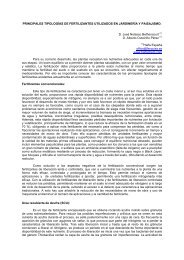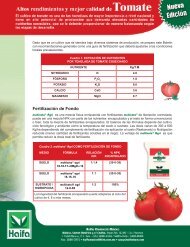Crop Guide: Nutritional recommendations for Cucumber - Haifa-Group
Crop Guide: Nutritional recommendations for Cucumber - Haifa-Group
Crop Guide: Nutritional recommendations for Cucumber - Haifa-Group
Create successful ePaper yourself
Turn your PDF publications into a flip-book with our unique Google optimized e-Paper software.
1. General in<strong>for</strong>mation<br />
1.1 The origin of cucumbers<br />
The cucumber most likely originated in India<br />
(south foot of the Himalayas), or possibly<br />
Burma, where the plant is extremely variable<br />
both vegetatively and in fruit characters. It has<br />
been in cultivation <strong>for</strong> at least 3000 years. From<br />
India the plant spread quickly to China, and it<br />
was reportedly much appreciated by the<br />
ancient Greeks and Romans. The Romans used<br />
highly artificial methods of growing the<br />
cucumber when necessary to have it <strong>for</strong> the<br />
Emperor Tiberius out of season.<br />
Columbus brought the cucumber to the New<br />
World, along with many other vegetables. He<br />
had them planted in Haiti in 1494, and possibly<br />
on other islands.<br />
Most of the distinct types of cucumber grown today were known at least 400 years ago. Present<br />
<strong>for</strong>ms range from thick, stubby little fruits, three to four inches long, up to the great English<br />
greenhouse varieties that often reach a length of nearly two feet.<br />
1.2 Botanical taxonomy<br />
The cucumber (Cucumis sativus L.) belongs to the Cucurbitaceae family, one of the more important<br />
plant families. The Cucurbitaceae consists of 90 genera and 750 species. The genus Cucumis<br />
contains nearly 40 species including three important cultivated ones (i.e., C. anguria L. [West Indian<br />
gherkin], C. sativus [cucumber], and C. melo L. [cantaloupe]).<br />
Other important crop plants in the Cucurbitaceae family are watermelon (Citrullus vulgaris Schrad),<br />
muskmelon (Cucumis melo L.), squash and pumpkin (Cucurbita pepo L., C. mixta Pang., C. moschata<br />
Poir., and C. maxima Duch.), and loofah gourd (Luffa cylindrical Roem.). Fig-leaf gourd (Cucurbita<br />
ficifolia Bouche) is also cultivated to some extent, but it is even more important as a diseaseresistant<br />
rootstock in the grafting of greenhouse cucumbers.<br />
4<br />
Figure 1.1: Different shapes and colors of<br />
several cucumber variety fruits












